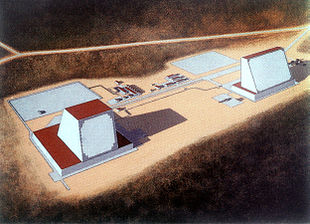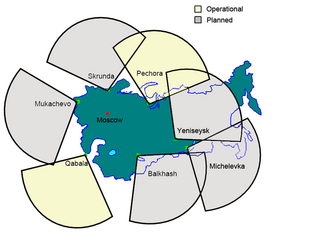Daryal radar
 Daryal radar in Pechora | |
| Country of origin | Soviet Union, Russia |
|---|---|
| Introduced | 1984 |
| No. built | 8 planned, 2 operational |
| Type | Early-warning radar |
| Frequency | 150–200 MHz (VHF) |
| Range | Around 6,000 kilometres (3,728 mi)[1][2]: 74 |
| Diameter | Transmitter 30×40 m Receiver 80×80 m separated by 0.5–1.5 km |
| Azimuth | 90°[1][2]: 74 |
| Elevation | 40°[2]: 74 [1] |
| Other Names | NATO: Pechora GRAU: 5N79, 90N6. |
The Daryal-type radar (Russian: Дарьял) (NATO: Pechora) is a Soviet bistatic early-warning radar. It consists of two separate large active phased-array antennas separated by around 500 metres (1,640 ft) to 1.5 kilometres (4,921 ft). The transmitter array is 30 m × 40 m (98 ft × 131 ft) and the receiver is 80 m × 80 m (260 ft × 260 ft) in size. The system is a VHF system operating at a wavelength of 1.5 to 2 meters (150 to 200 MHz). Its initial transmit capacity was 50 MW with a target capacity of 350 MW.[3][failed verification]
The designer of the radars, RTI Mints, says that each Daryal receiver is 100 × 100 m and has 4,000 cross dipoles. Each transmitter is 40 × 40 m with 1,260 modules, each capable of 300 kW. They say the radar has a range of 6,000 km with targets between 0.1–0.12 m2.[4][2]: 74 It can track 20 objects at the same time and can cope with four jamming sources.[2]: 74 The designer, Viktor Ivantsov, was awarded the title "Hero of Labour" for his work on the Daryal.[5]
The first Daryal type radar was an active electronically scanned array built at Olenegorsk in 1977. It was the receiver building only and was called a Daugava rather than a Daryal. It used the transmitter of the adjacent Dnestr-M radar. Following this two Daryal radars were constructed in Pechora (1983) and Qabala (1985). New Daryal-U radars were planned for Balkhash-9 near Sary Shagan in Kazakhstan, Mishelevka near Irkutsk and Yeniseysk-15 near Krasnoyarsk in Siberia. Two Daryal-UM systems were to be constructed in Skrunda, Latvia, and Mukachevo, Ukraine.[6][7][8]
Originally, at least seven Daryal facilities were planned, however, only the first two facilities completed, named Pechora and Gabala, were ever operational.
The American Clinton administration offered financial assistance in completing the Mishelevka facility in exchange for amending the Anti-Ballistic Missile Treaty to allow US deployment of a national missile defense system.[9] Russia rejected this proposal and in 2002 the US unilaterally withdrew from the ABM treaty. The Mukachevo one in Ukraine was never completed after the fall of the Soviet Union and the Skrunda facility was demolished by a newly independent Latvia, arranged by the US Department of Defence.[6][10] The Yeniseysk (Krasnoyarsk) Daryal-U site caused concern in the West over compliance with the ABM Treaty during its construction in the 1980s. Article VI(b) requires radars to be on the periphery of national territory and to face outwards whereas the Yeniseysk radar faced over Siberia. Following negotiations, in September 1989 the Soviets admitted it was a violation of the treaty, construction ceased and the facility was eventually dismantled.[6][8][11][12]
Variants
The prototype Daryal receiver is called a Daugava (5U83) and works with a Dnestr-M transmitter. It is half the size of the Daryal receivers but has the same equipment and computer systems.[13]
The original Daryal (5N79) was improved by revisions Daryal-U (90N6) and Daryal-UM.[14][15] A Daryal-U had half the transmitters of a Daryal.[13] The Volga radar (70M6) is a Daryal-like radar operating on a decimeter wavelength (UHF) rather than the meter wavelength (VHF) of the Daryal. It was originally planned that there would be a number of these to complement the Daryal. The only Volga built is the one at Baranavichy which originally started in 1982, stopped in the early 1990s, restarted in 1999 and became operational in 2003.[6]
-
A US military artist's concept of a Daryal facility - transmitter on the left, receiver on the right
-
Planned and operational Daryal radars
-
Ruin of Daryal-UM radar at Mukachevo Radar Station, Ukraine (2003)
Locations
References
- ^ a b c Радиолокационная станция "Дарьял" [Radar Daryal] (in Russian). Russian Ministry of Defence. n.d. Archived from the original on 2013-01-24. Retrieved 2012-02-08.
- ^ a b c d e Nikolai Spassky, ed. (2002). Encyclopedia "Russia's Arms and Technologies. The XXI Century Encyclopedia": Volume 5 — "Space weapons" (in English and Russian). Moscow: Publishing House "Arms and Technologies". ISBN 978-5-93799-010-5.
- ^ "Pechora LPAR - Daryal". GlobalSecurity.org. n.d. Archived from the original on 2011-12-04. Retrieved 2011-12-22.
- ^ Мощные РЛС дальнего обнаружения РЛС СПРН и СККП [Powerful radar early warning system and space surveillance] (in Russian). RTI Mints. n.d. Archived from the original on 2012-12-30. Retrieved 2012-01-30.
- ^ История РТИ [History of RTI] (in Russian). RTI Mints. n.d. Archived from the original on 2012-01-08. Retrieved 2012-01-07.
- ^ a b c d e f Podvig, Pavel (2002). "History and the Current Status of the Russian Early-Warning System" (PDF). Science and Global Security. 10 (1): 21–60. Bibcode:2002S&GS...10...21P. CiteSeerX 10.1.1.692.6127. doi:10.1080/08929880212328. ISSN 0892-9882. S2CID 122901563. Archived from the original (PDF) on 2012-03-15.
- ^ Bukharin, Oleg; Kadyshev, Timur; Miasnikov, Eugene; Podvig, Pavel; Sutyagin, Igor; Tarashenko, Maxim; Zhelezov, Boris (2001). Podvig, Pavel (ed.). Russian Strategic Nuclear Forces. Cambridge, Massachusetts: MIT Press. ISBN 978-0-262-16202-9.
- ^ a b Karpenko, A (1999). "ABM AND SPACE DEFENSE". Nevsky Bastion. 4: 2–47. Archived from the original on 2013-01-28.
- ^ "Mishelevka". GlobalSecurity.org. n.d. Archived from the original on 2012-07-06. Retrieved 2011-12-22.
- ^ a b "LPAR facility". Controlled Demolition, Inc. Archived from the original on 2012-10-14. Retrieved 2011-12-23.
- ^ "Yeniseysk (Krasnoyarsk)". GlobalSecurity.org. n.d. Archived from the original on 2012-05-23. Retrieved 2011-12-22.
- ^ "TREATY BETWEEN THE UNITED STATES OF AMERICA AND THE UNION OF SOVIET SOCIALIST REPUBLICS ON THE LIMITATION OF ANTI-BALLISTIC MISSILE SYSTEMS". 1972. Archived from the original on 2011-10-21. Retrieved 2012-01-21.
- ^ a b Ilyin, A (June 2012). "Воронеж" в сердце Азии [Voronezh at the heart of Asia] (in Russian). Novosti Kosmonavtiki. Archived from the original on 2016-03-03. Retrieved 2012-10-13.
- ^ O'Connor, Sean (2009). "Russian/Soviet Anti-Ballistic Missile Systems". Air Power Australia. p. 1. Archived from the original on 2012-12-02. Retrieved 2012-01-07.
- ^ Holm, Michael (2011). "1st Missile Attack Early Warning Division". Soviet Armed Forces 1945-1991. Archived from the original on 2016-03-01. Retrieved 2012-01-07.
- ^ Shko (2008). "Panoramio is no longer available" СПРН [SPRN (early warning)] (photograph) (in Russian). Archived from the original on 2013-10-06. Retrieved 2012-01-08.
- ^ SityShooter (2011). "РЛС "Днестр" - "Днепр-М" (actually is Daugava left)" [Radar Dnestr-Dnepr-M] (photograph) (in Russian). Archived from the original on 2015-09-24. Retrieved 2012-01-29.
- ^ Podvig, Pavel (December 10, 2012). "Russia suspended operations of the early-warning radar in Gabala". Russian Strategic Nuclear Forces. Archived from the original on 2015-03-15. Retrieved 2015-01-14.
- ^ Стоит в Печоре монолит [It is a monolith in Pechora] (Video) (in Russian). Волна-плюс [Volna-Plus]. 2005.
- ^ Podvig, Pavel (2011-06-21). "Daryal-U radar in Mishelevka demolished". Russian Strategic Nuclear Forces. Archived from the original on 2013-04-20. Retrieved 2012-01-30.
- ^ Safiullin, Rakhim (2005-09-08). Пожар на сооружении №2, 17 сентября 2004 года [Fire in building number 2, September 17, 2004] (in Russian). Archived from the original on 2012-04-26. Retrieved 2011-12-22.
- ^ Presenter: Игорь Воеводин [Igor Voevodin] (2011-03-21). "Разрушение Красноярской РЛС [The destruction of the Krasnoyarsk radar]". Ностальгия [Nostalgia] (in Russian). Pravda. Archived from the original on 2011-11-12. Retrieved 2011-12-23.
- ^ josef s (2007). "jenisseisk 15" (photograph). Archived from the original on 2016-03-04. Retrieved 2012-05-01.


